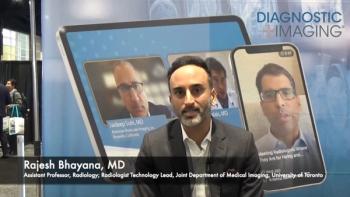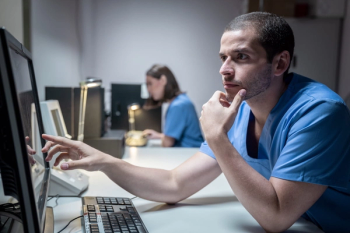
Siemens casts Tim as its unifying thread
Above and around the Siemens Healthcare booth at the ISMRM meeting, the message “pushing the boundaries of MR” was as clear as it could be. The theme was driven home by pennants featuring iconic reconstructions of athletes into whole-body 2D renditions of muscles and organs. How the company pushes these boundaries, however, had been more subtext than headline, an issue Siemens vice president of marketing for MR Don Fowler set out to resolve on the ISMRM exhibit floor.
Above and around the Siemens Healthcare booth at the ISMRM meeting, the message "pushing the boundaries of MR" was as clear as it could be. The theme was driven home by pennants featuring iconic reconstructions of athletes into whole-body 2D renditions of muscles and organs. How the company pushes these boundaries, however, had been more subtext than headline, an issue Siemens vice president of marketing for MR Don Fowler set out to resolve on the ISMRM exhibit floor.
Displays and presentations throughout the booth struck a common chord, showcasing Tim, the company's total imaging matrix coil and radiofrequency technology introduced five years ago, as the unifying thread that ties Siemens' many MR scanners together.
"The strategy has always been there," said Fowler, who stepped into his VP role in January. "I just wanted to bang the drum louder."
Siemens over the past several years has expanded its portfolio to eight scanners, the most recent added during RSNA 2007: a second 3T scanner, the premium-performance Verio, and a fourth 1.5T system, the budget-priced Essenza. While offering one of the most extensive lines of MR scanners in the industry, particularly at the high end, Siemens risked confusing customers, Fowler said. Tim takes care of that problem, serving as the focal point that brings the portfolio into sharp focus, he explained.
Tim allows the value-oriented 1.5T workhorse Essenza to achieve maximum productivity in routine clinical work; the wide-bore, ultracompact 1.5T Espree to handle obese or claustrophobic patients without clinical compromise; and the 3T Verio to support both academic and clinical studies.
But, as important as Tim was to the Siemens message, it was not all of it, certainly not at the research-oriented ISMRM meeting.
"It's great to have all this fancy technology, but you need the applications and you need to know where those applications make clinical sense," he said. "And that is what's great about this show, having the best and the brightest challenging what makes good clinical sense."
Newsletter
Stay at the forefront of radiology with the Diagnostic Imaging newsletter, delivering the latest news, clinical insights, and imaging advancements for today’s radiologists.




























